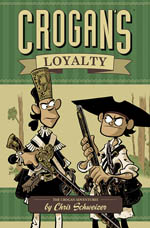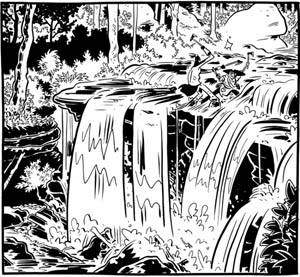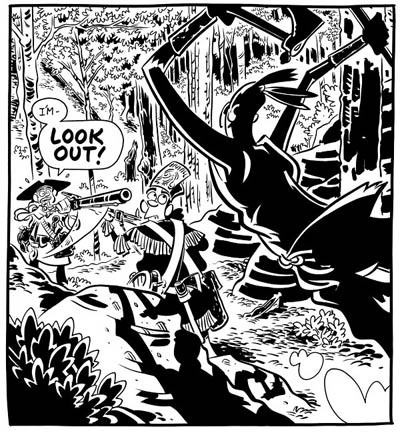 By Chris Schweizer
By Chris Schweizer
184 pages, black and white
Published by Oni Press
It’s nice to be dependable, and that’s a word I’d used to describe Chris Schweizer’s Crogan’s Adventures series of graphic novels. Debuting in 2008 with the pirate romp of Crogan’s Vengeance and continuing in 2010 with the Foreign Legion desert adventure of Crogan’s March, I’ve liked the idea of every two years getting a new volume. That trend’s continued with this year’s American Revolution story of Crogan’s Loyalty. And when I said that Schweizer was dependable, I wasn’t just talking about his publishing schedule; I know by now that each new story in the Crogan family tree is going to be a good, solid graphic novel.
Each of the Crogan graphic novels opens with a framing scene set in the present day, as Dr. Crogan and his wife deal with their energetic sons, Eric and Cory. Inevitably a story is told by Dr. Crogan about one of their ancestors, and from there we dip into the past. This time we get a story about two Crogans, Charles and William Crogan who fought on opposing sides of the Revolutionary War. And as we learn about the bonds of brotherhood and country, it rapidly becomes a story where it’s clear that it’s not ever easy to put one of the two ahead of the other.
 In the hands of another creator, I think this basic thrust for Crogan’s Loyalty could come across as extremely cheesy. Fortunately, that’s not the case with Schweizer. With Crogan’s Loyalty, Schweizer side-steps that potential pitfall by giving us a strong look into both of the Crogan brothers’ heads and their loyalties, both to country and one another. In the opening framing sequence, Dr. Crogan quickly establishes that there isn’t a simple "one is good, one is bad" divide between the two, but rather a case where two people each fought for what they felt was right. It’s an important distinction to be made right at the start, because it sets Crogan’s Loyalty off on the right foot with the reader. Schweizer never makes Charles or William’s side of the war automatically the better one, something that succeeds in part because none of this is set during any major battles or events. It’s a small-scale story, where the relationship between the two brothers as well as with William’s love for local farmer Bess are what’s at stake.
In the hands of another creator, I think this basic thrust for Crogan’s Loyalty could come across as extremely cheesy. Fortunately, that’s not the case with Schweizer. With Crogan’s Loyalty, Schweizer side-steps that potential pitfall by giving us a strong look into both of the Crogan brothers’ heads and their loyalties, both to country and one another. In the opening framing sequence, Dr. Crogan quickly establishes that there isn’t a simple "one is good, one is bad" divide between the two, but rather a case where two people each fought for what they felt was right. It’s an important distinction to be made right at the start, because it sets Crogan’s Loyalty off on the right foot with the reader. Schweizer never makes Charles or William’s side of the war automatically the better one, something that succeeds in part because none of this is set during any major battles or events. It’s a small-scale story, where the relationship between the two brothers as well as with William’s love for local farmer Bess are what’s at stake.
Early in the book, we get a good look at the two brothers interacting in a friendly manner. It’s one of my favorite parts of Crogan’s Loyalty, as they finish each other’s sentences, trade stories about favorite memories, and generally laugh and have a good time. The sequence comes across extremely natural and not forced; you genuinely get the feeling that these two characters know and love one another, even as they continue to hold ideological differences. That’s something that certainly exists in families today, and I suspect a lot of readers will be able to see people they know reflected in the faces of Charles and William Crogan. When the balance of power begins to shift back and forth between the two—and that shift is important because it lets us see how each would act when they have they upper hand—we’re still able to remember that friendly rapport between the two and keep that in mind even as things begin to go south. I have a suspicion that most people will ultimately have a favorite Crogan between the two brothers by the end of Crogan’s Loyalty, but I appreciate that Schweizer never forces that decision on us through a narrative proclamation; at no point are we point-blank told whom we should cheer for.
 It also doesn’t hurt that Crogan’s Loyalty is beautifully drawn from start to the finish. Unlike the earlier volumes, set on sailing ships or in either the desert or underground, here Schweizer’s story is deep in the wilderness, and that means a series of lush locations for him to draw. As a result we get tons of trees, rocks, streams, and even a climactic scene at a small waterfall. And sure, it’s a tiny bit of a cliche to have a fight over a waterfall, but it looks so great that it’s hard to complain (and it fits with the overall story).
It also doesn’t hurt that Crogan’s Loyalty is beautifully drawn from start to the finish. Unlike the earlier volumes, set on sailing ships or in either the desert or underground, here Schweizer’s story is deep in the wilderness, and that means a series of lush locations for him to draw. As a result we get tons of trees, rocks, streams, and even a climactic scene at a small waterfall. And sure, it’s a tiny bit of a cliche to have a fight over a waterfall, but it looks so great that it’s hard to complain (and it fits with the overall story).
More importantly, the art of Crogan’s Loyalty is about more than just the backgrounds. I like how Schweizer draws his characters; wide-eyed and open-faced, it’s a good thing that none of them are professional poker players because what we see is what we get. It’s an attractive look, and it lends itself to a lot of smooth motion across the page; everything from raising a rifle to hurling an axe comes across like we’re seeing it actually animated instead of as a static image. Schweizer also does a good job of blocking his panels and pages to draw the eye to just the right moments; when the brothers are suddenly, attacked, for instance, the Indian is cast in shadow so that he’s almost a force moving towards them. You see the Indian, then you see the brothers and the "Look out!" word balloon that he’s hurtling towards. There’s no way for the Indian to blend into the background here, grabbing your attention instantly.
Crogan’s Loyalty is another strong addition to the Crogan’s Adventures books. I love that each one stands on its own—you can absolutely read them in any order—and that Schweizer has once again given his book just the right pacing. After the deliberately abrupt ending of the main story for Crogan’s March (which was great but also cruel), long time readers will probably be a little happier with how Schweizer ends Crogan’s Loyalty; it ends at just the right moment, with a bit of epilogue told in the present day. Even better, I think the framing structure for present day sequence is at its best in this book; it’s got a lot more emotional heft than the previous two, and once again, Schweizer concludes that story at just the right moment. Crogan’s Loyalty is another winner from Schweizer. My only complaint is that when each book ends, it makes me want to read the next one right away. Crogan’s Loyalty is a charmer, through and through.
Purchase Links: Amazon.com | Powell’s Books
